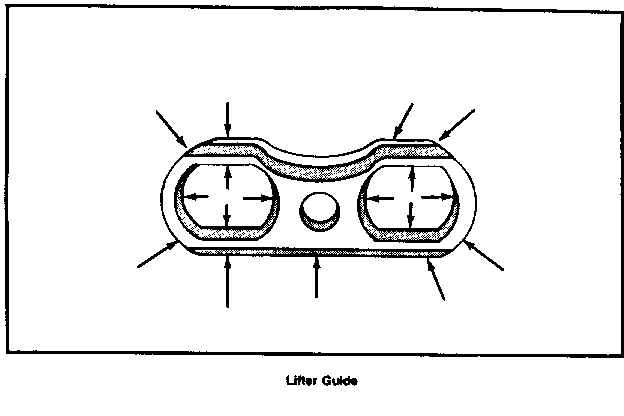LIFTER NOISE DIAGNOSIS CORRECTION PROCEDURE

Model and Year 1982-85 10-30 C, K, G, P WITH 6.2L DIESEL ENGINES
TO: ALL CHEVROLET DEALERS
When diagnosing the cause of lifter noise, the following checks should be made after the noise has been isolated to a specific cylinder:
1. Remove the suspected cylinder's rocker arm assembly.
2. Remove pushrods.
3. Move each lifter up and down in its bore, using a magnet or special tool J-29834. The lifter must move freely.
4. Remove clamp and guide.
5. Rotate lifter in its bore. Lifter must rotate and move up and down freely.
6. Remove, inspect, and test lifter assembly.
7. Inspect the lifter's guide for contact areas to lifter on the guide's inner edges (see illustration.) Be sure that there are no burrs or sharp edges contacting the lifter assembly.
8. Inspect the guide's outer edge for burrs and sharp edges that could contact the cylinder block (see illustration.) Outer surfaces of the guide with burrs or sharp edges must be filed or ground off.
9. When reinstalling the guide, use two long screwdrivers and lightly pry the two guides towards each other while tightening the clamp assembly retainer bolt.
10. Recheck lifter movement per Step No. 3.
11. Reassemble engine as outlined in the Service Manual.
NOTICE: If a condition is found in any of the previous steps, it should be corrected before continuing.
NOTICE: Injection pump lines not properly clamped with isolators and contacting each other will cause abnormal engine noises. Loose fuel and brake lines in frame rails will also cause abnormal vehicle sounds that can lead technicians to believe they are coming from the engine. A thorough inspection of all lines (fuel, brake, air conditioning, etc.) and the dipstick tube to ensure they are properly positioned, clamped, and bracketed should be administered when diagnosing any engine noise condition.

General Motors bulletins are intended for use by professional technicians, not a "do-it-yourselfer". They are written to inform those technicians of conditions that may occur on some vehicles, or to provide information that could assist in the proper service of a vehicle. Properly trained technicians have the equipment, tools, safety instructions and know-how to do a job properly and safely. If a condition is described, do not assume that the bulletin applies to your vehicle, or that your vehicle will have that condition. See a General Motors dealer servicing your brand of General Motors vehicle for information on whether your vehicle may benefit from the information.
